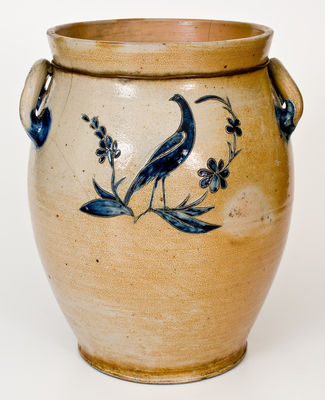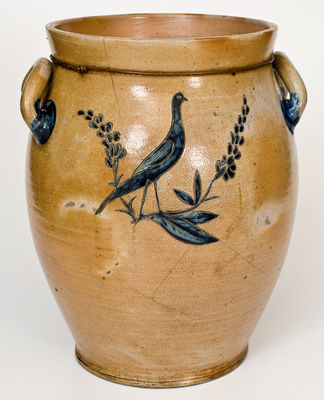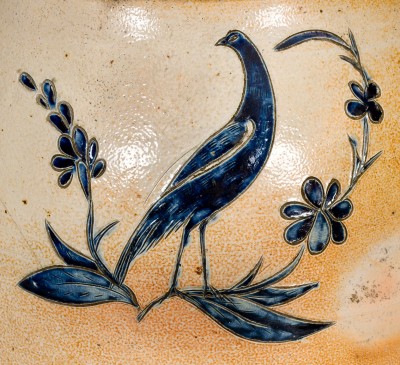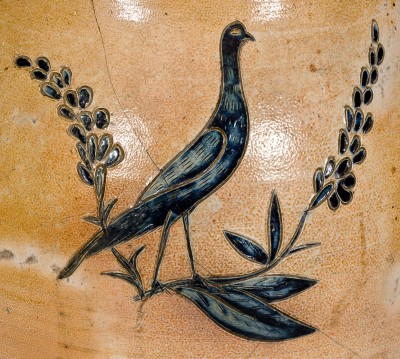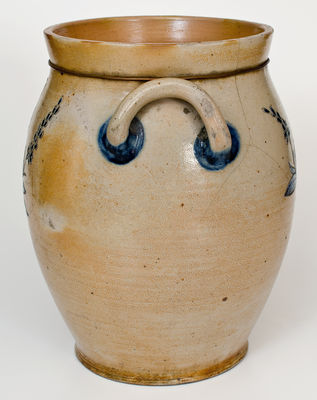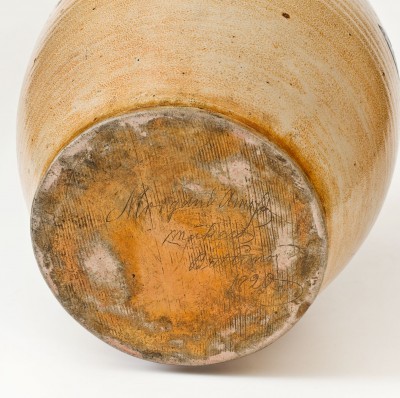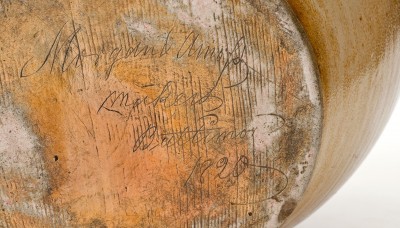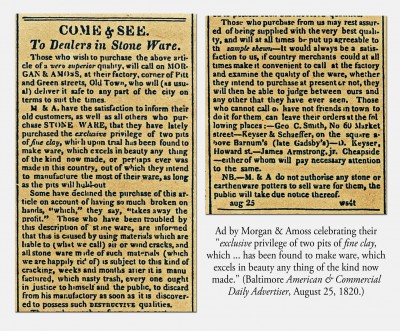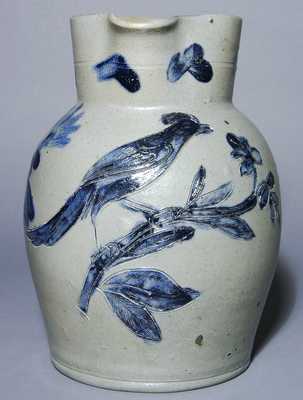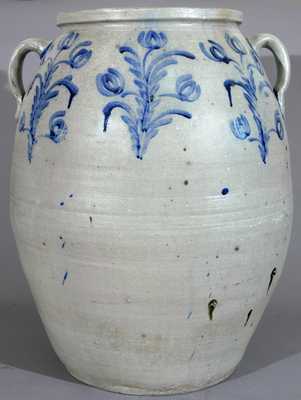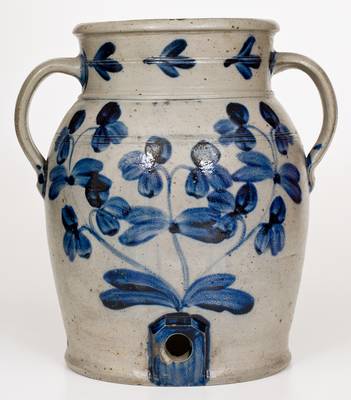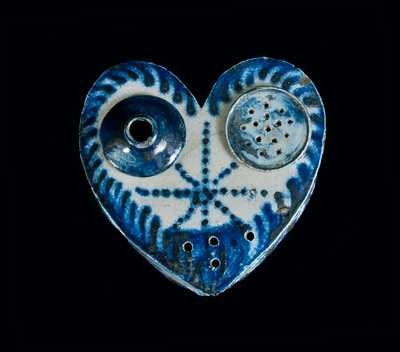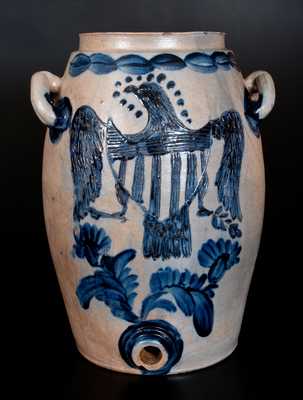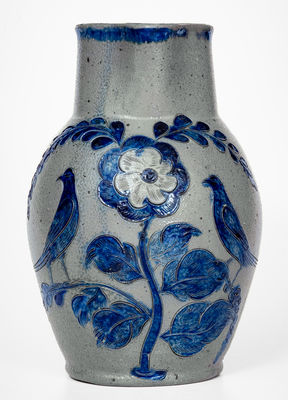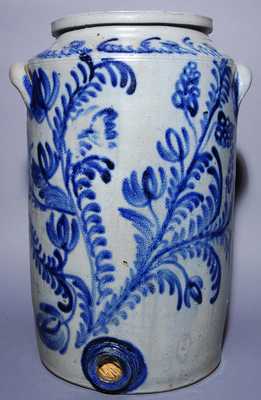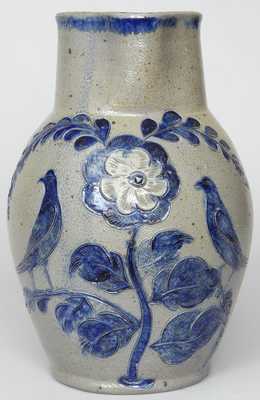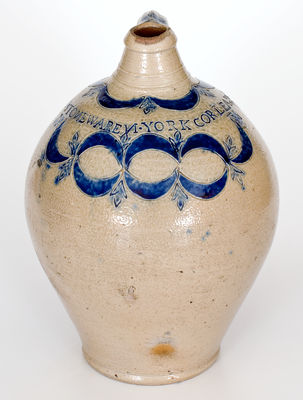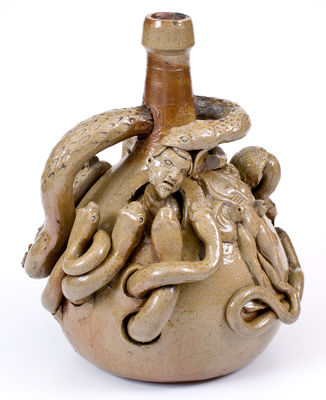Exceedingly Rare and Important Four-Gallon Stoneware Jar with Incised Bird-and-Floral Decorations, Incised "Morgan & Amoss / makers / Baltimore / 1820," William Morgan and Thomas Amoss, Baltimore, MD, 1820, thin-walled, ovoid jar with footed base, flared collar, and open loop handles. Decorated on the front and reverse with different incised and cobalt-highlighted designs of a bird flanked by flowering plants. Brushed cobalt highlights to handle terminals. Incised on the underside in script "Morgan & Amoss / makers / Baltimore / 1820." This delicately-potted and decorated jar is the only known example of incised stoneware bearing the signature of early Baltimore potters, William Morgan and Thomas Amoss. Famously illustrated on the cover of Ceramics in America 2005, it is regarded as one the most refined examples of American stoneware that we have ever offered. Potted with a light-colored clay exhibiting minimal "orange peel" to the surface, it was likely produced from a clay source advertised by Morgan and Amoss on August 25, 1820: "M & A have the satisfaction to inform their old customers as well as all others who purchase stone ware that they have lately purchased the exclusive privilege of two pits of fine clay, which upon trial has been found to make ware, which excels in beauty any thing of the kind now made, or perhaps ever was made in this country, out of which they intend to manufacture the most of their ware, as long as the pits will hold out." Characteristic of Morgan and Amoss's best work, the jar features an elegant, thin-walled construction uncommon in American stoneware from any period, more reminiscent of the thickness of redware. Its scarce open-handled form, is based on the Manhattan style, the standard of American stoneware production of the period, and was possibly influenced by the Remmeys' arrival in Baltimore eight years prior. Standard pieces produced by Morgan & Amoss have simplistic and less-decorative tab handles. The vessel's bird-and-floral motifs are also related to the Remmey style, but feature their own distinctive characteristics, most notable in the intricate, fully-enclosed incising of the flowers' petals. In addition, the birds, with their narrow heads, slender necks, and long legs, have an almost crane-like appearance- differing from typical Remmey avian motifs and giving the jar a decidedly more-formal appearance reminiscent of Chinese porcelain. The different decorations on each side of the jar, which include forward-facing and turned-head attitudes to the birds, reveal the decorator's proficiency and add artistic appeal to the vessel. The incised signature on the underside includes a very early 1820 date and the name of William Morgan's partner at the time, Thomas Amoss, a figure instrumental in both Baltimore and Richmond stoneware traditions. (While involved in his Baltimore partnership, Amoss also worked with potter, Samuel Frayser, at the former pottery of Richard Randolph along Four Mile Creek, near Richmond, from 1818-1821, and independently in the area until his death in 1822. Richmond pieces produced with forms and decorations related to Amoss's Baltimore work have survived.) Baltimore pieces produced at William Morgan's shop after Amoss's tenure, circa 1822-1827, include an incised birds-in-tree-decorated water cooler, which sold in Crocker Farm's July 20, 2013 auction, lot 1, setting a record at the time for a ceramic object made in the state of Maryland. Equally rare and beautiful, this jar is emblematic of the heightened level of artistry found in Baltimore's early stoneware industry- arguably the zenith of American stoneware production. Literature: Illustrated on the cover of Ceramics in America 2005; also illustrated and discussed in Kille, "Distinguishing Marks and Flowering Designs: Baltimore's Utilitarian Stoneware Industry," Ceramics in America 2005, pp. 105-106, figs. 24, 25, 26. An 11 1/4" spider crack from rim on one side. A 7 1/2" Y-shaped crack from rim on opposite side. A shallow in-the-firing chip to one handle. A small chip to underside at edge. Old copper wire around rim, unnecessary, but kept on the jar as part of its history of use. H 14 1/2".

